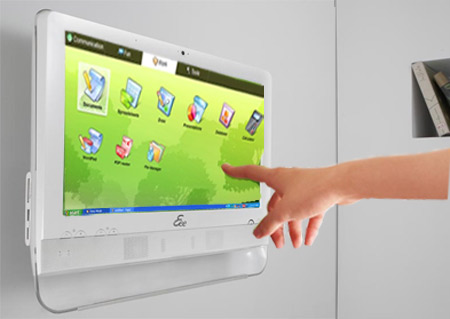The Touch Screen PC and the Modern Environment: Applications and Future Uses
Published on 08 March 13
2663
0
The touch screen PC isn’t a new thing, despite its apparent novelty. We have been using touch screen technology in industrial and commercial applications for a very long time indeed - since the 1990s, where the most common variants on the technology were (and still are) self-service ticket machines and cash points.
What is new is the ubiquity of touch screen technology as a whole. The touch screen PC is no longer confined to the worlds of industrial stock management; reference library and museum information points; or the ticket sales and cash machines already mentioned. Now, most of us have a touch screen computer in our pockets. We call it a smart phone, but that’s essentially what it is.
The technology allowing touch screens to work is based on one of three things: resistance; surface waves; or capacitance. A resistance screen (the ticket sales machine at a train station uses this technology) is essentially a big button with sensitivity to being pressed in different areas. The feedback the screen gives on which are has been pressed translates to the appropriate action, as codified by the microprocessor at the heart of the system.
The surface wave touch screen PC works by passing what is effectively a sound wave across its surface. The touch disrupts the sound wave and the processor is able to identify the precise location of the disruption according to feedback information. This type of touch screen is very sensitive and may be disrupted by dust or other contaminating particles.
The most commonly used touch screen technology now is capacitance. Here, objects that have a conductive property (electrically) can cause the screen to sense touch by distorting the electrical field produced by a thin conductive layer. The human finger carries an electric current - which is how the touch screen PC is able to register such precise touching movements on its part.

Users of touch screens with a capacitance base will know that you can’t do anything with such a device when wearing gloves. As a result, special touch screen gloves have been developed, which mimic the electric signal of the human finger. This allows the user to manipulate the data on a small hand held touch screen PC even in very cold conditions.
The modern ubiquity of the touch screen format is leading to sea changes in the ways in which we connect with the world. It is no longer necessarily the case that the touch screen must be located on or in a fixed item, to which the user must go to retrieve or input information. Instead, as noted, information retrieval and input can be done with pocket PCs.
Larger systems may begin to use pocket touch screen interfaces to communicate with the original terminal, or to replace it altogether. A good example of this is the handheld unit that a supermarket worker may use to order new stock; or the museum information point. IN the first instance, the portable terminal can be used to send information immediately to a central ordering system. In the second, the static museum information point may be replaced by a handheld touch screen item, which more closely resembles the audio guide format. Interactive information may be accessed using a touch screen rather than by pressing buttons on a closed headset system: thereby giving a genuinely visual accessory to the exhibition.
James Pattrick is a technology writer. He is currently researching a book on the evolution of the touch screen pc.
What is new is the ubiquity of touch screen technology as a whole. The touch screen PC is no longer confined to the worlds of industrial stock management; reference library and museum information points; or the ticket sales and cash machines already mentioned. Now, most of us have a touch screen computer in our pockets. We call it a smart phone, but that’s essentially what it is.
The technology allowing touch screens to work is based on one of three things: resistance; surface waves; or capacitance. A resistance screen (the ticket sales machine at a train station uses this technology) is essentially a big button with sensitivity to being pressed in different areas. The feedback the screen gives on which are has been pressed translates to the appropriate action, as codified by the microprocessor at the heart of the system.
The surface wave touch screen PC works by passing what is effectively a sound wave across its surface. The touch disrupts the sound wave and the processor is able to identify the precise location of the disruption according to feedback information. This type of touch screen is very sensitive and may be disrupted by dust or other contaminating particles.
The most commonly used touch screen technology now is capacitance. Here, objects that have a conductive property (electrically) can cause the screen to sense touch by distorting the electrical field produced by a thin conductive layer. The human finger carries an electric current - which is how the touch screen PC is able to register such precise touching movements on its part.

Users of touch screens with a capacitance base will know that you can’t do anything with such a device when wearing gloves. As a result, special touch screen gloves have been developed, which mimic the electric signal of the human finger. This allows the user to manipulate the data on a small hand held touch screen PC even in very cold conditions.
The modern ubiquity of the touch screen format is leading to sea changes in the ways in which we connect with the world. It is no longer necessarily the case that the touch screen must be located on or in a fixed item, to which the user must go to retrieve or input information. Instead, as noted, information retrieval and input can be done with pocket PCs.
Larger systems may begin to use pocket touch screen interfaces to communicate with the original terminal, or to replace it altogether. A good example of this is the handheld unit that a supermarket worker may use to order new stock; or the museum information point. IN the first instance, the portable terminal can be used to send information immediately to a central ordering system. In the second, the static museum information point may be replaced by a handheld touch screen item, which more closely resembles the audio guide format. Interactive information may be accessed using a touch screen rather than by pressing buttons on a closed headset system: thereby giving a genuinely visual accessory to the exhibition.
James Pattrick is a technology writer. He is currently researching a book on the evolution of the touch screen pc.
This review is listed under
Hardware
Community
Related Posts:
Post a Comment

 James
James


